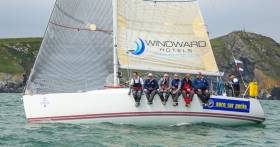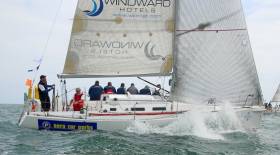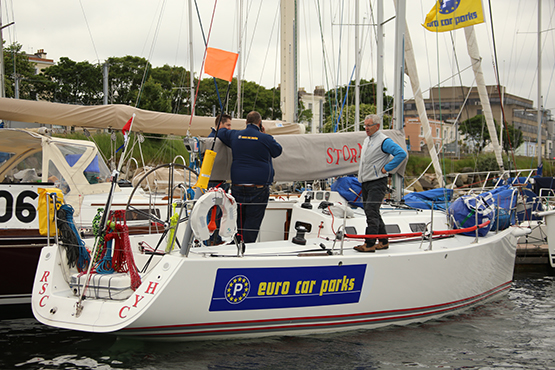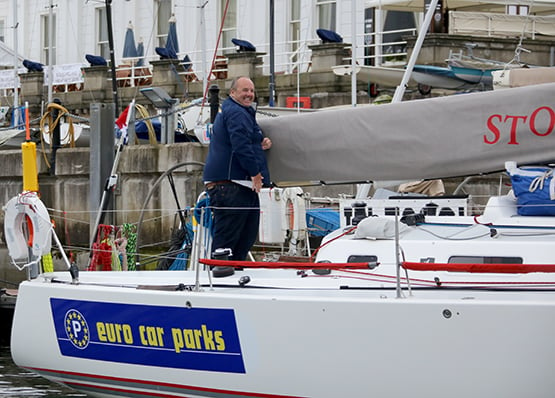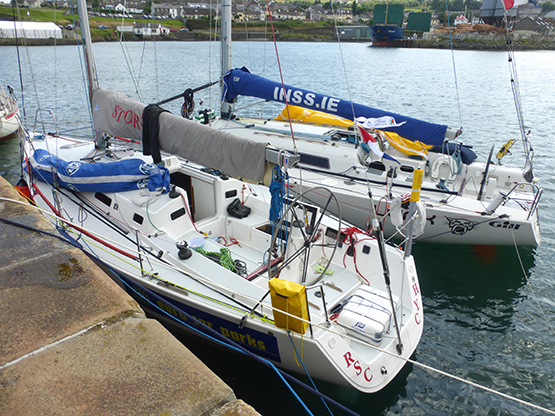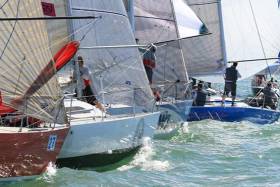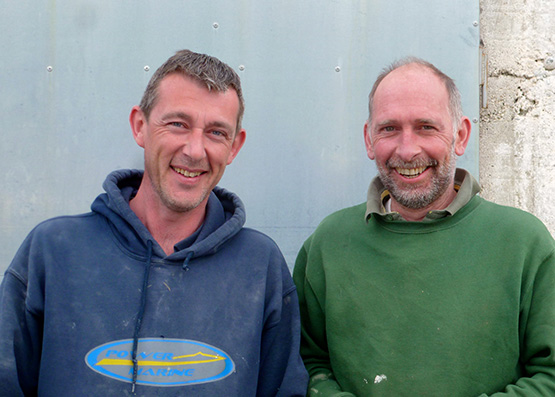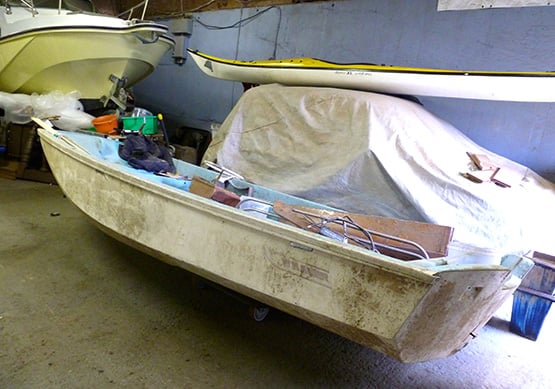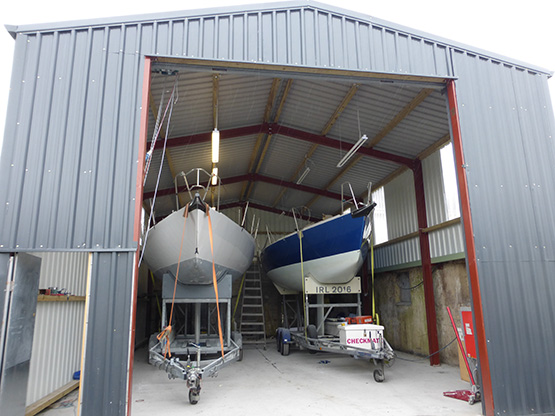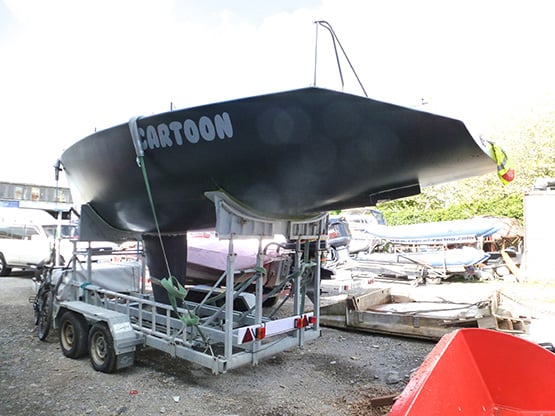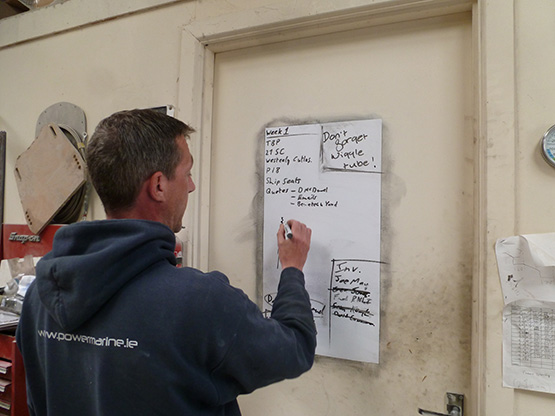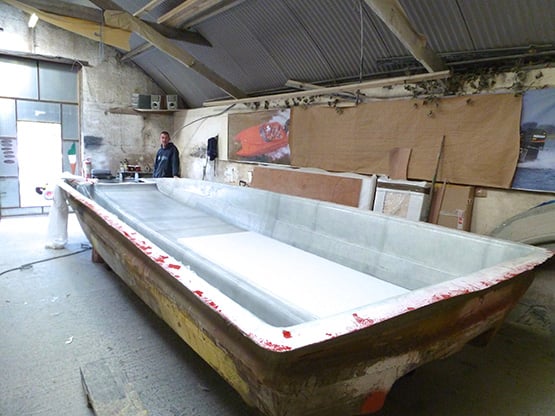Displaying items by tag: David Cullen
Dave Cullen Is Afloat.ie 'Sailor Of The Month' For June
While the Volvo Round Ireland Race 2016 was the most international ever seen, some of the keenest racing was among the Irish boats in a fleet of such quality that just to secure a class win was to have made an outstanding achievement.
In the end, while there were many Irish boats which were there or thereabouts in their respective classes, there was only one class winner from Ireland. And that was Dave Cullen of Howth racing the chartered J/109 Euro Car Parks.
Although he has raced round Ireland in a Half Tonner in times past, the enthusiastic Cullen reckoned that for today’s fleets, a J/109 offers a better proposition. So he left his lavishly-maintained Half Tonner Checkmate at home, and put his usual eclectic crew of all the talents aboard the chartered J/109 which became Euro Car Parks.
Yet despite the very evident sponsorship, this was by no means a “no expenses spared” campaign. It was run on a tight budget, and it relied on the talents of such as Mark Mansfield and Maurice “Prof” O’Connell in the crew to bring the boat home on time.
And it was a mighty test of character. They weren’t well placed passing the Tuskar, but in the harsh slug along the south coast, Euro Car Parks crew sailed like men possessed, and by the time they were approaching the Fastnet, all the other J/109s were nowhere, relatively speaking.
But there were many other boats in the fleet and in Class 3 to give them a hard time, and the second setback came off the mouth of Bantry Bay early on the Monday morning. The good winds had moved a few miles further north, and Euro Car Parks found herself headed inside Dursey Head, requiring a painful beat in a lumpy sea to get back on track.
By that time their most significant class rival, Paul O’Higgins’ new higher-rated JPK 10.80 Rockabill VI, was making such good progress up the west coast that she rounded Tory Island forty miles ahead of Euro Car Parks. Yet the Cullen crew never slackened the pace, and when a localized calm at Inishtrahull stopped Rockabill VI for an excruciating three hours, the J/109 kept up the pressure, going from being far astern to relatively close astern by the time Rockabill got going again.
For the smaller craft, the rest of the race was torture, as the big winds which had sent the leaders and larger craft round at such speed were now fading, and the final agony was a period of calm eastward of Drogheda on the Wednesday evening. Yet they kept going, they were in the hunt and at the finish for Class 3 on IRC it was Euro Car Parks first, Rockabill VI second, and Conor Fogerty’s Sunfast 3600 Bam! third, making Dave Cullen our Afloat.ie Sailor of the Month for June 2016.
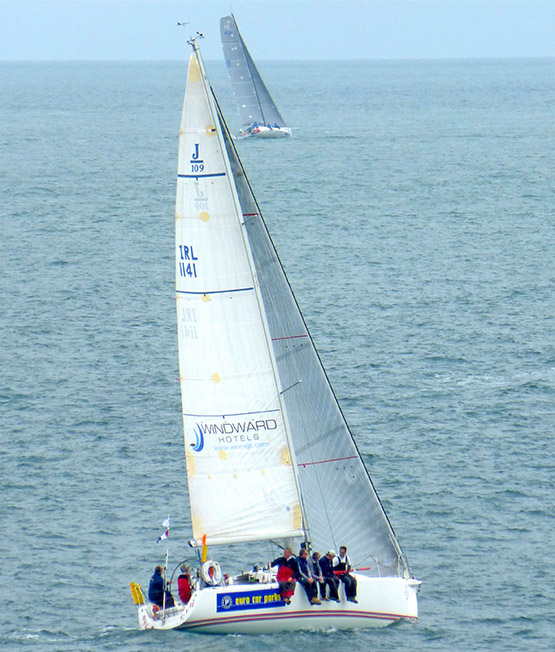
Taking a charter boat with old sails, borrowing a few other sails, filling it with a crew whose average age is nearly 50 might not sound like a recipe for success against some full–on campaigns but when Howth YC skipper David Cullen put six ICRA National Champions in his crew line up he was always going to be a potent force. Here, Cullen describes how his J109 Euro Car Parks entry was the only Irish class winner of this month's Volvo Round Ireland Race.
With the big Five Oh approaching, I felt it was time to revisit a challenge that I hadn’t participated in for 18–years so decided to participate in this year’s Volvo Round Ireland Race. Perhaps my close interest in following the Volvo Ocean Race was part of the inspiration or perhaps the start of a mid-life crisis, but regardless of why it was time to put the best campaign affordable together.
As my own half tonner Checkmate was too small (even though I did one previously in a half tonner), it was time to look at the charter route. Given Rambler 88 was a certainty to steal the monohull line honours prize, I decided early on that the goal should be a class win on IRC.
Inspection of the previous two races results showed a narrow defeat of a J109 in the last race so this seemed to be a good option. At that time, there were no JPKs entered so this looked like a realistic proposition and I didn’t have to look much further than my own Howth Yacht Club to find Storm which is one of Ireland’s leading J109s.
Above and below: Pre–race preparations along side at the Royal Irish Yacht Club in Dun Laoghaire. Photo: Afloat.ie
With a deal done, then it was time to assemble a crew. With a core crew from Checkmate to include Aidan Beggan, John Murphy, Gary Cullen, Eddie Bourke and Franz Rothschild, I needed some J109 expertise to bolster the crew. I regard one of my better moves as recruiting Mark Mansfield and Maurice “Prof” O’Connell to bring along their significant J109 boat speed experience which paid off handsomely.
Prof had just come from a class win in ICRA Nationals class zero aboard Jump Juice. Mark had, for the second year, just won ICRA class one aboard J109 Joker II. Both were obviously in good form and both had vast experience of setting up and sailing J109’s quickly. Added to that both were well known drivers. In offshore racing, drivers and trimmers with a good navigational plan is what makes the difference.
Crew complete, it was now time to start the crew and boat preparations. Not realising the safety requirements for the race, several of the crew were quickly enlisted in First Aid, VHF and Sea Safety courses. These were all very enjoyable and valuable and in retrospect, I am sorry I did not complete these years ago. I cannot recommend these courses enough even if you are not going offshore as surprising how little we actually knew despite the huge miles we had all logged.
We then moved on to the boat preparations. As Storm was an inshore boat it didn’t have a Code Zero which I ordered from Norths so we had a complete suite of sails (along with a bit of borrowing). Next was to organise the financials. I had an original budget of €20k but this ended up closer to €35k so I was glad of the support of Euro Car Parks and Windward Hotels to supplement the costs. The boat was rechristened Euro Car Parks for the race.
With an average age of 48, we weren’t taking any short cuts on safety so I installed all new safety equipment, harnesses, EPIRB, flares etc for peace of mind. Ocean Safety also assisted in this aspect.
We then spent two weeks getting the boat ready for sea. As the J109 is not really an offshore boat, we devised ingenius additional bunks and sleeping arrangements whilst replacing many of the high load bearing systems and adding a bobstay to the pole. We completely underestimated the time required for preparing the boat and several midnight work parties meant we started the race tired which is a lesson for next time. AIS and wifi was added so we could run Expedition on the laptop and also comms were improved to enable data to get forecasts, grib files, etc.
Food was our next thought and Franz took on the role of provisioner and chef. Decision was to go the pressure cooker route with frozen meals and nobody could fault his food choices.
Our IRC Championships the week before the race left us with little boat practice but six of the crew started as IRC Champions from various boats so the pedigree was good.
Before the race, Paul O’Higgins purchased a JPK1080 Rockabill VI which was favourite for our class but there were several other boats including some experienced J109s so we weren’t sure where we would end up but podium was a definite goal.

Euro Car Parks (pictured above on port tack) was deemed 'on course side' at the start of the race
The forecast the day before the race indicated a light start, reach up the West coast and light finish; all ideal for a J109 and lulling us into a false sense of comfort. What arrived was quite at odds with that forecast.
The morning of the race had c10–knots south westerly which was great for our start, had I not put us over the line at the gun! We had the walk of shame back to the line to restart but at least we got some press coverage, albeit for the wrong reason.

Mark Mansfield and Prof O'Connell shortly after the start
Rambler 88 and the MOD 70s disappeared in the blink of an eye and we were left trying to play catch up with our fleet. It didn’t take us too long to get back into contention but we ended up in an Easterly position when approaching Tuskar Rock which definitely was not the favoured side. That said, although behind, we were back in contention. Our food plans meant the use of spoons and bowls for the race so you can imagine the look on our faces when all the spoons went overboard when emptying a bucket! One teaspoon fed the crew for the rest of the race supplemented by the clever use of Doritos.
As the night drew in, it was clear that we were in for a windy beat along the south coast so we agreed as a crew to push it! All of the crew spent the next 24 hours on the rail in truly miserable conditions of pelting rain and c.30knots of breeze with big seas. We pushed on with full main and a J2 whilst similar boats carried a lot less sail and at the end of the ordeal, we were in contention for first place in Class. Food was cancelled and a staple diet of jelly beans and water kept us going.
"One teaspoon fed the crew for the rest of the race supplemented by the clever use of Doritos"
Whilst the Round Ireland is renowned for the scenery, our roundings of Fastnet, Skelligs and Blaskets were fairly miserable in grey, windy and wet conditions. As we rounded Mizen Head, so did the wind to stay on the nose until we got to Kerry when finally the breeze went abeam and the rain stopped.
A fast beam reach up the west coast was most welcome but also suited Rockabill VI even better, who by Donegal had over an hour advantage on handicap. Proper food reappeared to warm our spirits.
At this point the boat, all of our gear and all of the crew were saturated so a run along the top gave us the opportunity to dry the boat thoroughly and catch up on some rest. Inspired by some loud U2 and Seal, morale improved where we saw ourselves making handicap gains into Rockabill VI and a favourable Northern passage put us ahead by the infamous Rathlin. For a change we made the tidal change at slack tide and with some breeze started the long push south in a light southerly breeze.
Again it was rail time for the beat down the Irish Sea which was in moderate breeze and dry so no real complaints.
We now had Rockabill VI in our sights approaching Rockabill Lighthouse but a dying breeze made for a very difficult night where we were both becalmed several times. Although tempted to drop the hook, we persevered to approach
Dublin Bay at one knot still on the coat tails of the JPK. The Yellow Brick tracker was nearly worn out with our constant tracking and we started to understand the AIS debate on the Volvo Ocean Race.
Approaching Greystones and Wicklow and the infamously calm Six Mile Point, we eeked forward in an increasingly foul tide just long enough to get inshore behind Rockabill VI and about two hours behind them. This was in fact how we finished and with them owing us over 3½ hours, the Class win was ours.
Clearly the race was a big boat affair. the smaller boats including ourselves were virtually on the wind for the whole race, bar from the Skelligs to Rathlin, thats two thirds of the course. The larger boats were able to lay all the way along the west cost without a tack. In the end the breeze also died allowing the larger boats to claim all the podium positions. Some years it is a small boat race, some a big boat race. This year it was for the big ones. Whilst we were never in contention for overall on IRC which was won by Rambler 88, we had been up to third overall but the lighter conditions at the end finished us in a credible fifth overall.
Class 3 winner Euro Car Parks safely back in Wicklow harbour. Photo: W M Nixon
The famous Wicklow Welcome could not have come quick enough after 118 hours and 55 minutes at sea and it wasn’t long before various members of our crew were found asleep in showers, toilets, etc with a beer in their hands!
On reflection, we got several of the decisions right and the choice of boat and crew being the key ones leading to a harmonious and fun trip despite the misery. We even got a chance to revisit “offshore” stories of old that cannot be put to print so we ticked all the boxes.
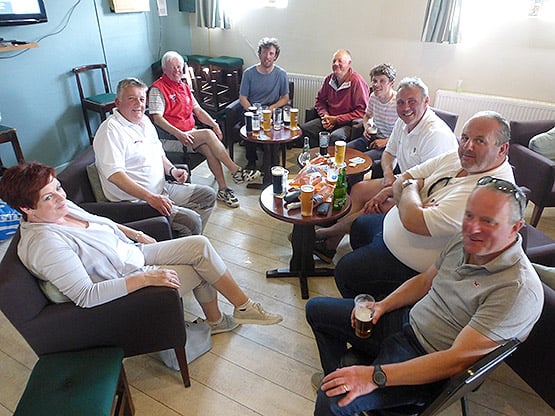
The essential post-race de-briefing – the crews of Euro Car Parks and Rockabill VI, leaders in Class 3, get together in Wicklow SC on Thursday afternoon after five days of racing against each other round Ireland. Photo: W M Nixon
I have two years to decide whether to do it again but I am tempted to go again in a 109 but next time it will be 109 feet!
The next big event for us is to try and retain the Half ton Cup trophy which we won last year. Most of the crew now switch their attentions back to Checkmate for the event in Falmouth in August. Mark, however joins our clubmate Mike Evans on Big Picture for the same event so it will be interesting to see what each of us has picked up from each other over the five days of Round Ireland. Two other well tickled up Half Tonners from Howth, Harmony and King one, will Join us at that event to bring the Irish representation to four boats.
See Round Ireland tracker here Afloat's Round Ireland 2016 coverage is here and download overall results here
The attraction of boats and the sea as a year-round fascination is something which by-passes many people. And even in summer – particularly if it’s a typical Irish summer – you’d sometimes be hard put to explain the appeal of our eccentric sport in its multiple manifestations to those who were only taking a polite interest in the first place. W M Nixon adds to the mystery by considering the unexpected interactions which come up on a typical day as the new season creaks into action.
“It’s an old Boston Whaler” says Grant McEwen, “a very old Boston Whaler. Long forgotten too, by the look of it. Most people would have thought it was fit only for the landfill site But the new owner wants it restored to best original order, proper Concours d’Elegance stuff. What do you think of that?”
“It’s absolutely marvellous” says I. “By my reckoning, the Boston Whaler in all its manifestations is classic. You just can’t do too much good work by a proper classic boat. Go for it!”
The men who work on boats in hidden workshops – Alan Power and Grant McEwen out the back of Malahide. Photo: W M Nixon
This tired-looking Boston Whaler may be as much as fifty years old, but with the proper restoration skills in Malahide she’ll be brought to Concours d’Elegance standards as a real classic. Photo: W M Nixon
We’re in one of those semi-secret little places where boat nuts gather. It’s a yard up the back of Malahide out the back of a small business park, a place where little one and two-man businesses - some of them in the marine industry - have clustered, because the reality of waterfront property in the Dublin area is that it has become much too expensive to provide decent premises for boat businesses operating on very tight margins.
Yet in these hidden and unassuming places, you’ll find some really amazing things going on. But they’re amazing only if you’re a dyed-in-the-wool boat enthusiast. So we’re not even talking about all sailing people here. Some sailing and boating people just don’t want to know about the hidden details of boats and their equipment, and how things came to be that way. They just want to go sailing, or zip around the sea under power. The work behind the scenes is not for them.
But for the rest of us, sailing and boating are of heightened interest because they’re vehicle sports. The vehicles themselves are every bit as interesting as the sport you can have with them. And from that, of course, there springs the notion that with a bit of change here and there - a minor tweak of this, and a minor adjustment of that – then hey presto, you’ve got a much improved boat.
As it happens, the finding of this Boston Whaler brought in for the Lazarus treatment was a fortuitously associated event, as I’d called to this secret yard in Malahide to shoot the breeze with one of Grant’s neighbours, Alan Power. He is known among the cognoscenti as the man to go to when you want your boat modified in interesting ways. He’s the kind of genius with epoxies and whatnot who will cheerfully take on a challenge which other workers around boats couldn’t even contemplate, let alone try.
Yet Alan will take on the job, and he has done so with such success in recent years that he has had an additional new shed built on the only spare bit of ground left in this secret yard, a shed big enough to accommodate two Half Tonners side by side.
“We’ve a World Champion out the back”. Re-vitalised Half Tonners The Big Picture (left) and World Champion Checkmate in Power Marine’s new shed in Malahide. Photo W M Nixon
Half Tonners are boats around the 30ft LOA mark which were all the rage as the hottest international level rating keelboat class around 30 years ago, when they were so highly-regarded that the likes of Olympic sailing legend Paul Elvstrom of Denmark got intensely involved. But this level of participation ultimately led to a sort of self-immolation of the class, even though the boats were still around, though now racing as ordinary handicap craft.
But as the years have passed, people have come to realize that the Half Tonner is a very manageable proposition as a classic, and thanks to modern construction, many examples of the great designs of the class’s golden years have survived remarkably well. All they need is a bit of TLC and maybe a bit of repair and tweaking here and there, and this is where Alan Power of Power Marine comes in, for no-one does it better.
The irony of it all is that Alan himself is a powerboat fanatic, both building and racing. Last weekend he was competing with the Irish contingent in the major international powerboat event at Torquay in Devon, Rounds 1 & 2 of the RYA British OCR (Offshore Racing Circuit) Championship. Roughly speaking, it’s the powerboat equivalent of saloon car racing, and this time round it was Alan’s brother Mark, navigated by Carl Kendellen, who showed best with a sixth in class and ninth overall. But in times past Alan has frequently been on the podium, and he has some Gold Medals to show for his efforts. So now that he has the new shed up and running, he has been able to devote his original shed to one of his personal pet projects, a very hungry looking powerboat to his own designs.
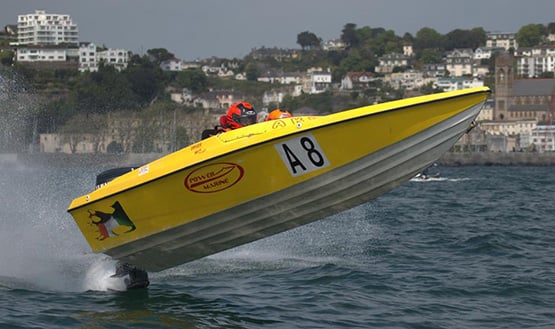
Mark Power’s boat was the most successful of the Irish contingent at last weekend’s Offshore Circuit Racing (ORC) event in Torquay in Devon
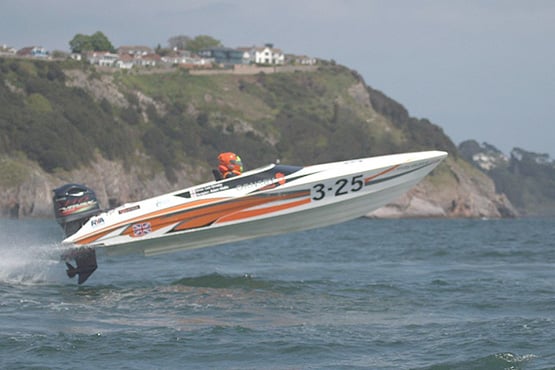
This British competitor at last weekend’s Torquay series was a successful Power Marine export order
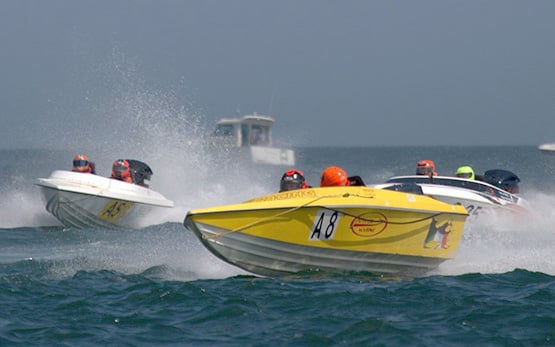
Powering ahead. Mark Power and Carl Kendellen find themselves in the sweet place in last weekend’s racing
It may seem odd that the development of a new prototype racing powerboat is in a sense being funded by the maintenance and modification requirements of handicap racing sailboats, but either way it’s specialist boat-building, and the skills are very transferable.
Fortunately, Alan hasn’t set himself too strict a deadline on this particular new craft, for with the economy picking up again, people are getting around to commissioning those modifications on sailboats that they’ve had in mind for some time, and as well there’s always a steady stream of repair work at Power Marine.
A month ago, the new shed was busy with two of the top Half Tonners in dock, Dave Cullen’s World Champion Classic half Tonner Checkmate XV and the Evans brothers’ The Big Picture. Checkmate is now afloat and competing, but The Big Picture is having further mods made, and meanwhile waiting outside is Ken Lawless’s handy little Quarter Tonner Cartoon, which is in the yard to get the Power treatment for her rudder.
Ken Lawless’s Quarter Tonner Cartoon in Power Marine for some fine tuning of the rudder
Once again, this is where boat nuts and ordinary sailors part company. For your ordinary sailor, a rudder is just a rudder. But for boat nuts, a rudder is a source of endless fascination, an item for almost eternal modification. What with creating the best-possible endplate effect at the hull, or reducing turbulence from the trailing edge, for your boat nut there’s not really a rudder on the planet which can’t be improved, however infinitesimally small the mods might be.
For non-enthusiasts, this might seem like something akin to debating how many angels can dance on the head of a pin, but I remained happily absorbed in a brief lecture by Alan – complete with sketches on a whiteboard – on the ideal configuration for the trailing edge of a rudder, which is not a knife edge as you’d expect, but is instead a small flat cutoff at about 45 degrees.
The artist in his studio – Alan Power sketching out the ideal trailing edge for a Quarter Tonner’s rudder. Photo: W M Nixon
The visit to Power Marine was prompted by a sunny Bob Bateman photo we had here on Afoat.ie a few days back of a Half Tonner swanning along in classic yachting style. This evoked contrasting memories of seeing Alan Power back in early April when work was going flat out on the two Half Tonners, and there was ample evidence of the dust-creating ability of an adult angle-grinder, with the man himself emerging from the back of the shed looking like something out of a horror movie. For sure, it’s wonderful to think of people sailing along in that healthy style as shown by the Bateman photo. But just now and again it does no harm to remember how much effort has to go into bringing a boat such as a vintage Half Tonner up to full racing potential.
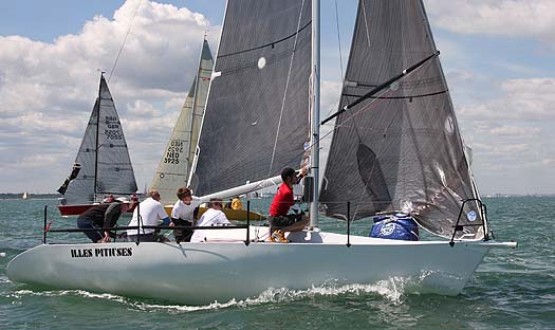
Champagne sailing. It was this idyllic image on Afloat.ie which prompted a visit to the dusty reality of a modern boatworking shed. Photo: Robert Bateman
Yet it would be pointless for all this effort to be put through in dusty premises unless the customers go out and sail and race the boat with the same dedication, and all credit to Dave Cullen, he does that very thing, and became our Sailor of the Month last August for trailing Checkmate XV to Belgium and winning the Half Ton Classics 2015.
He has an even busier season planned this year, as Checkmate has work to do at Dave’s home port of Howth in the ICRA Nationals from 10th to 12th June, but then a few days later he moves into a different scene with the complete charter of the Kelly family’s J/109 Storm, which becomes Euro Car Parks for the Volvo Round Ireland race on June 18th, crewed by five of the Checkmates plus Maurice Prof O’Connell - as the Checkmates who won the Half Ton Worlds make up a Who’s Who of Irish sailing talent, this is one potent challenge.
But Checkmate herself isn’t forgotten, for in August she has to defend her world title in Falmouth, which is as lovely a place to sail as you’ll find in a many a weeks voyaging. It’s all a very long way from a busy boatworking shed somewhere out the back of Malahide. But that’s the way it is with this crazy sport of ours.
Is it a bird? Is it a plane? Is it a bath……? No, it’s the mould for the new cathedral hull raceboat from Power Marine, which will be slightly similar to the red machine in the poster on the wall. Photo: W M Nixon


























